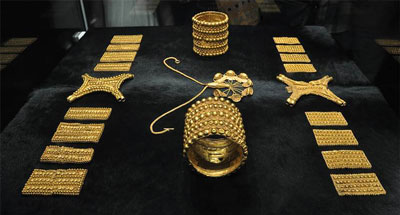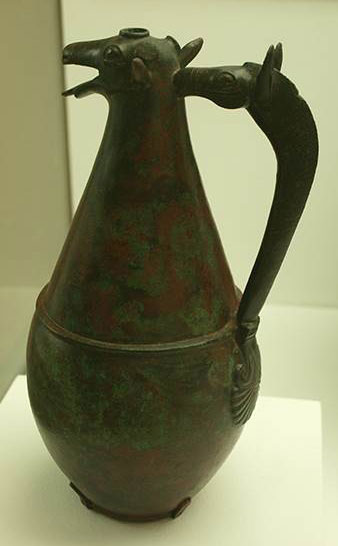Archaeological Discoveries
The discoveries published by Adolf Schulten in 1922 first drew attention to Tartessos and shifted its study from classical philologists and antiquarians to investigations based on archaeology, though attempts at localizing a capital for what was conceived as a complicated culture in the nature of a centrally controlled kingdom ancestral to Spain were inconclusively debated. Subsequent discoveries were widely reported: in September 1923 archaeologists discovered a Phoenician necropolis in which human remains were unearthed and stones found with illegible characters. It may have been colonized by the Phoenicians for trade because of its richness in metals.
A later generation turned instead to identifying and localizing "orientalizing" (eastern Mediterranean) features of the Tartessian material culture within the broader Mediterranean horizon of an "Orientalizing period" recognizable in the Aegean and Etruria.
 J.M. Luzón was the first to identify Tartessos with modern Huelva, based on discoveries made in the preceding decades. Since the discovery in September 1958 of the rich gold treasure of El Carambolo in Camas, three km west of Seville, and of hundreds of artifacts in the necropolis at La Joya, Huelva, archaeological surveys have been integrated with philological and literary surveys and the broader picture of the Iron Age in the Mediterranean basin to provide a more informed view of the supposed Tartessian culture on the ground, concentrated in western Andalusia, Extremadura and in southern Portugal from the Algarve to the Vinalopó River in Alicante.
J.M. Luzón was the first to identify Tartessos with modern Huelva, based on discoveries made in the preceding decades. Since the discovery in September 1958 of the rich gold treasure of El Carambolo in Camas, three km west of Seville, and of hundreds of artifacts in the necropolis at La Joya, Huelva, archaeological surveys have been integrated with philological and literary surveys and the broader picture of the Iron Age in the Mediterranean basin to provide a more informed view of the supposed Tartessian culture on the ground, concentrated in western Andalusia, Extremadura and in southern Portugal from the Algarve to the Vinalopó River in Alicante.
Alluvial tin was panned in Tartessian streams from an early date. The spread of a silver standard in Assyria increased its attractiveness (the tribute from Phoenician cities was assessed in silver). The invention of coinage in the 7th century BC spurred the search for bronze and silver as well. Henceforth trade connections, formerly largely in elite goods, assumed an increasingly broad economic role. By the Late Bronze Age, silver extraction in Huelva Province reached industrial proportions. Pre-Roman silver slag is found in the Tartessian cities of Huelva Province. Cypriot and Phoenician metalworkers produced 15 million tons of pyrometallurgical residues at the vast dumps of Riotinto. Mining and smelting preceded the arrival, from the 8th century BC onwards, of Phoenicians and then Greeks, who provided a stimulating wider market and whose influence sparked an "orientalizing" phase in Tartessian material culture (ca.750-550 BC) before Tartessian culture was superseded by the Classic Iberian culture.
"Tartessic" artifacts linked with the Tartessos culture have been found, and many archaeologists now associate the "lost" city with Huelva. In excavations on spatially restricted sites in the center of modern Huelva, sherds of elite painted Greek ceramics of the first half of the 6th century BC have been recovered. Huelva contains the largest accumulation of imported elite goods and must have been an important Tartessian center. Medellín, on the Guadiana River, revealed an important necropolis.
Elements specific to Tartessian culture are the Late Bronze Age fully evolved pattern-burnished wares and geometrically banded and patterns "Carambolo" wares, from the 9th to the 6th centuries BC; an "Early Orientalizing" phase with the first eastern Mediterranean imports, beginning about 750 BC; a "Late Orientalizing" phase with the finest bronze casting and goldsmiths' work; gray ware turned on the fast potter's wheel, local imitations of imported Phoenician red-slip wares.
 Characteristic Tartessian bronzes include pear-shaped jugs, often associated in burials with shallow dish-shaped braziers with loop handles, incense-burners with floral motifs, fibulas, both elbowed and double-spring types, and belt buckles.
Characteristic Tartessian bronzes include pear-shaped jugs, often associated in burials with shallow dish-shaped braziers with loop handles, incense-burners with floral motifs, fibulas, both elbowed and double-spring types, and belt buckles.
No pre-colonial necropolis sites have been identified. The change from a late Bronze Age pattern of circular or oval huts scattered on a village site to rectangular houses with dry stone foundations and plastered wattle walls took place during the 7th and 6th centuries BC, in settlements with planned layouts that succeeded one another on the same site. At Cástulo (Jaén), a mosaic of river pebbles from the end of the 6th century BC is the earliest mosaic in Western Europe. Most sites were inexplicably abandoned in the 5th century BC.
Tartessic occupation sites of the Late Bronze Age that were not particularly complex: "a domestic mode of production seems to have predominated" is one mainstream assessment. An earlier generation of archaeologists and historians took a normative approach to the primitive Tartessians' adoption of Punic styles and techniques, as of a less-developed culture adopting better, more highly evolved cultural traits, and finding Eastern parallels for Early Iron Age material culture in the Tartessian sites. A later generation has been more concerned with the process through which local institutions evolved.
The emergence of new archaeological finds in the city of Huelva is prompting the revision of these traditional views. Just in two adjacent lots adding up to 2,150 sq. m. between Las Monjas Square and Mendez Nuñez Street, some 90,000 ceramic fragments of indigenous, Phoenician and Greek imported wares were exhumed, out of which 8,009 allowed scope for a type identification. This pottery, dated from the 10th to the early 8th centuries BC predates finds from other Phoenician colonies; together with remnants of numerous activities, the Huelva discoveries reveal a substantial industrial and commercial emporion on this site lasting several centuries. Similar finds in other parts of the city make it possible to estimate the protohistoric habitat of Huelva at some 20 hectares, large for a site in the Iberian Peninsula in that period.
Calibrated carbon 14 dating carried out by Groningen University on associated cattle bones as well as dating based on ceramic samples permit a chronology of several centuries through the state of the art of craft and industry since the 10th century BC, as follows: pottery (bowls, plates, craters, vases, amphorae, etc.), melting pots, casting nozzles, weights, finely worked pieces of wood, ship parts, bovid skulls, pendants, fibulae, anklebones, agate, ivory - with the only workshop of the period so far proven in the west -, gold, silver, etc.…
The existence of foreign produce and materials together with local ones suggests that the old Huelva harbor was a major hub for the reception, manufacturing and shipping of diverse products of different and distant origin. The analysis of written sources and the products exhumed, including inscriptions and thousands of Greek ceramics, some of which are works of excellent quality by known potters and painters, has led some scholars to suggest that this habitat can be identified not only with Tarshish mentioned in the Bible, in the Assyrian stele of Esarhaddon and perhaps in the Phoenician inscription of the Nora Stone, but also with the Tartessos of Greek sources – interpreting the Tartessus river as equivalent to the present-day Tinto River and the Ligustine Lake to the joint estuary of the Odiel and Tinto rivers flowing west and east of the Huelva Peninsula

